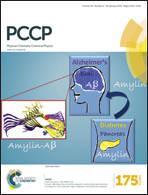Kinetics stabilized doping: computational optimization of carbon-doped anatase TiO2 for visible-light driven water splitting
Abstract
Using density functional theory calculation we investigate the carbon doping of anatase TiO2, a technique widely studied for visible-light driven water splitting. By a detailed analysis of the thermodynamics of C defects in TiO2, we show that any significant concentration of C dopants in the TiO2 lattice must be a result of non-equilibrium doping, which emphasizes the importance of kinetics stabilized C defects. Based on the band gaps calculated using hybrid density functionals, we exclude the possibility of C occupying Ti lattice sites or interstitial sites to enhance visible-light absorption of TiO2, as extensively discussed in the literature. Also, the recently proposed defect with a CO species occupying two O sites yields a too small band gap for water splitting. Two defects that can effectively reduce the band gap for the water splitting application are identified to be: (1) the CO–VO complex, i.e., a C substituting for O (CO) paired with an O vacancy (VO) and (2) the (C2)2O complex with a C dimer (C2) occupying two neighboring O vacancies. Compared with the CO–VO complex, (C2)2O exhibits strong binding (greater than 2.5 eV) between the two C atoms, which could significantly enhance its kinetic stability to survive from high temperature annealing. With a reduced band gap of about 1.4 eV, carbon dimers could be ideal for kinetic doping of anatase TiO2 to enhance its visible-light activity in photocatalytic reactions. Molecular doping using C2H2 or C2H4 as C precursors has been proposed to introduce the carbon dimers into TiO2.


 Please wait while we load your content...
Please wait while we load your content...